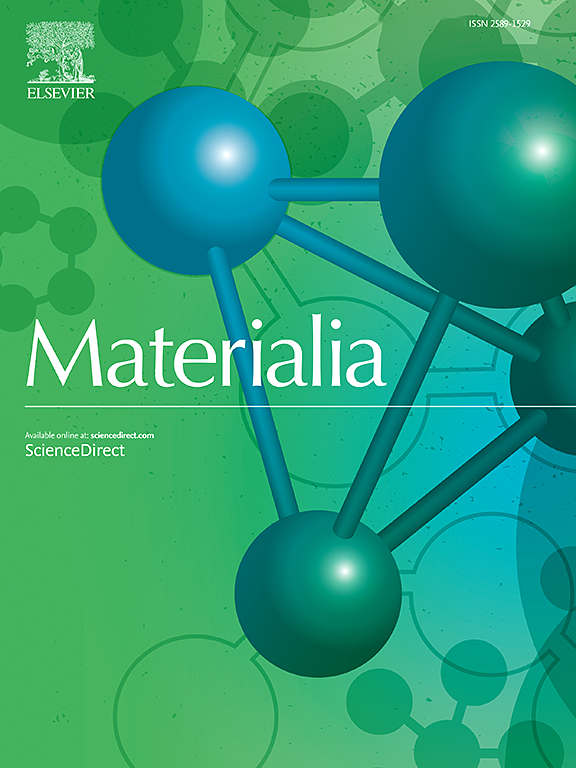Phase transformation and austenite stability during thermomechanical processing of high (∼5%) Al added low-density medium Mn steel
IF 3
Q2 MATERIALS SCIENCE, MULTIDISCIPLINARY
引用次数: 0
Abstract
In this study, a high Al added low-density medium Mn steel has been developed by conventional melting casting route in an open-air induction furnace, followed by hot forging and hot rolling in the temperature range of 1050-800°C. Finally, it has been intercritically annealed at 750°C for 5, 30, 60, 120, and 180 minutes. The microstructural analysis shows the presence of dual-phase microstructure of delta ferrite and austenite in cast as well as hot forged specimens. While some of the austenite has been transformed to martensite (lenticular shape) in rolled specimen due to a higher cooling rate (water quenching) immediately after hot rolling. After 5 minutes of annealing, needle shape of reverted austenite and intercritical ferrite forms from martensite. As the annealing time increases to 30 minutes, the reverted austenite coalesces and undergoes further transformation into ferrite. This results in the formation of reverted austenite with needle and globular morphologies at 60 minutes of annealing. This annealing condition reveals the optimum mechanical stability due to its morphology and chemical composition, resulting in enhanced TRIP effect as compared to other annealing conditions. Further increase in annealing time to 120 and 180 minutes, volume fraction of reverted austenite decreases significantly due to more dissolution of reverted austenite to intercritical ferrite, leading to reduced TRIP effect. Specimen annealed for 60 minutes, possessing optimal mechanical stability of austenite, exhibits tensile properties with an ultimate tensile stress of 658.45±6 MPa and total elongation of 12±0.95 %, attributed to enhanced TRIP effect.
高(~ 5%)Al添加低密度中Mn钢在热处理过程中的相变和奥氏体稳定性
本研究采用传统的露天感应炉熔铸工艺,在1050 ~ 800℃的温度范围内进行热锻、热轧,制备了一种高铝低密度中Mn钢。最后,在750°C下进行5、30、60、120和180分钟的临界间退火。组织分析表明,铸态和热锻态试样均存在δ铁素体和奥氏体的双相组织。而在热轧后立即进行较高的冷却速率(水淬),使部分奥氏体转变为马氏体(透镜状)。退火5分钟后,马氏体形成针状的还原奥氏体和临界间铁素体。当退火时间增加到30分钟时,还原奥氏体结合并进一步转变为铁素体。这导致在退火60分钟时形成具有针状和球状形态的还原奥氏体。由于其形态和化学成分,这种退火条件显示出最佳的机械稳定性,与其他退火条件相比,TRIP效应增强。进一步延长退火时间至120和180分钟,由于更多的还原奥氏体向临界间铁素体溶解,还原奥氏体的体积分数显著降低,导致TRIP效应减弱。退火60分钟后,由于TRIP效应的增强,试样的拉伸性能达到658.45±6 MPa,总伸长率为12±0.95%,奥氏体力学稳定性最佳。
本文章由计算机程序翻译,如有差异,请以英文原文为准。
求助全文
约1分钟内获得全文
求助全文
来源期刊

Materialia
MATERIALS SCIENCE, MULTIDISCIPLINARY-
CiteScore
6.40
自引率
2.90%
发文量
345
审稿时长
36 days
期刊介绍:
Materialia is a multidisciplinary journal of materials science and engineering that publishes original peer-reviewed research articles. Articles in Materialia advance the understanding of the relationship between processing, structure, property, and function of materials.
Materialia publishes full-length research articles, review articles, and letters (short communications). In addition to receiving direct submissions, Materialia also accepts transfers from Acta Materialia, Inc. partner journals. Materialia offers authors the choice to publish on an open access model (with author fee), or on a subscription model (with no author fee).
 求助内容:
求助内容: 应助结果提醒方式:
应助结果提醒方式:


